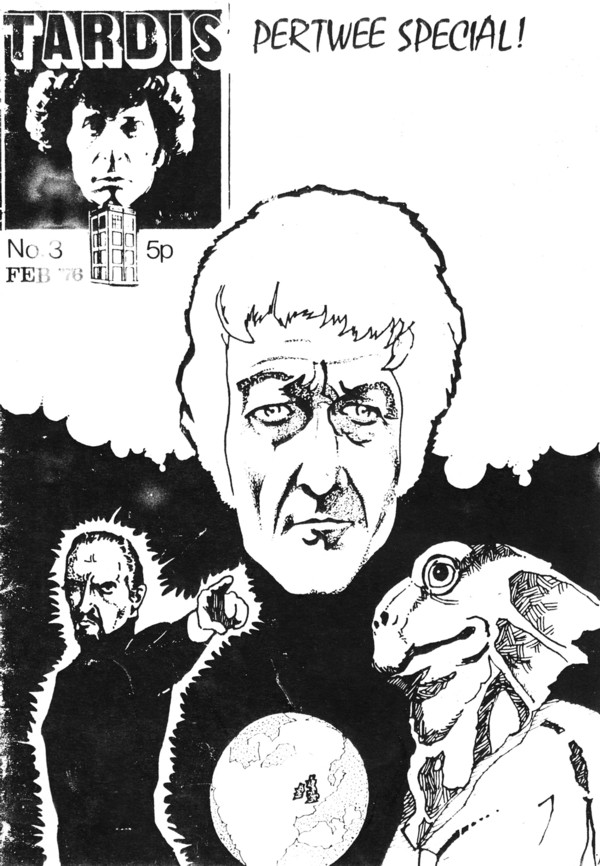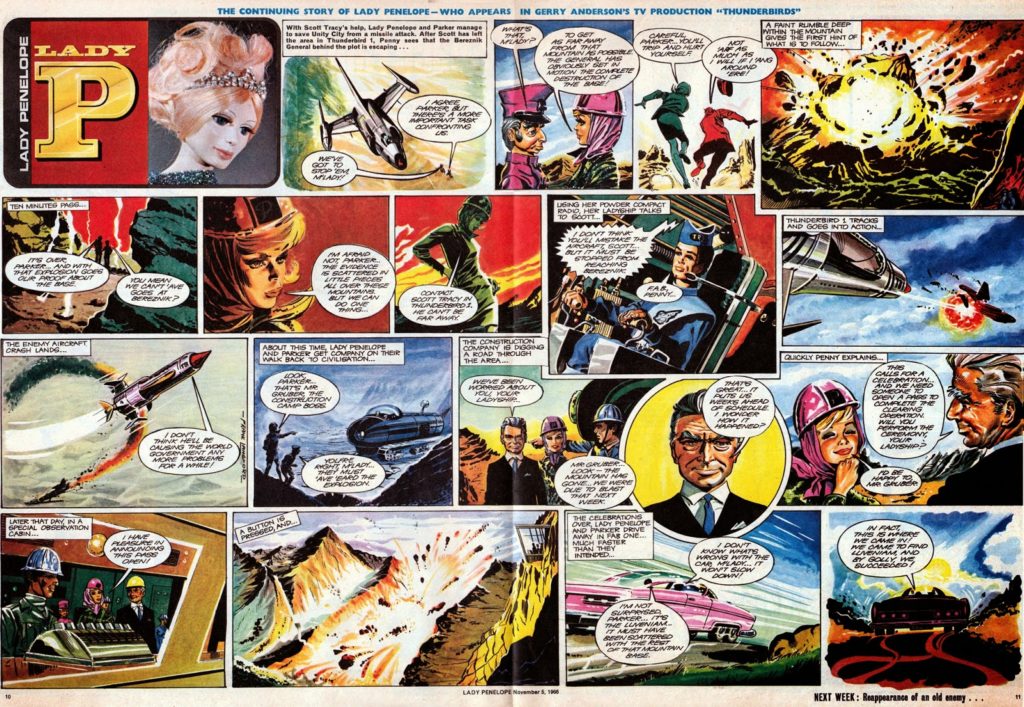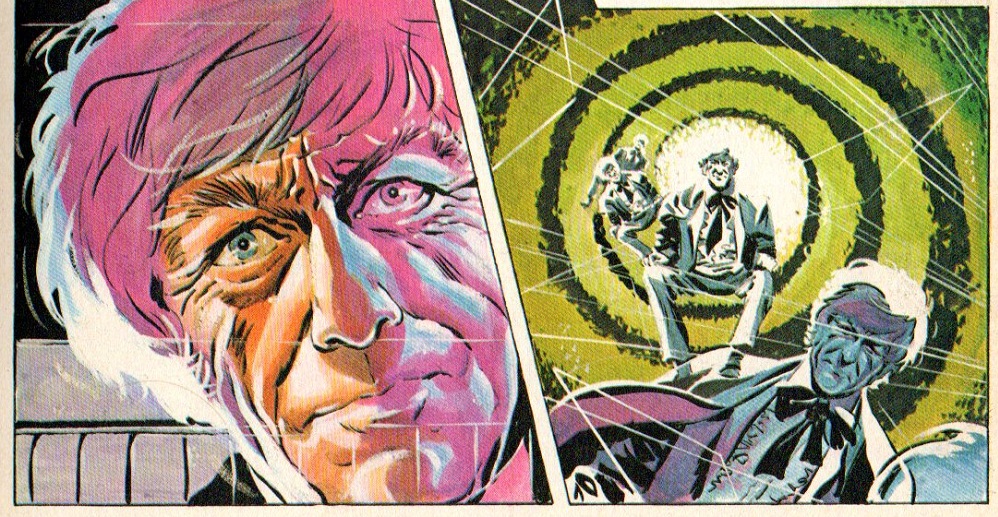
Frank Langford is a familiar name when it comes to comics having illustrated fan favourites like Thunderbirds’ Lady Penelope in the 1960s and BBC TV’s Doctor Who in the 1970s, yet when Gordon Blows interviewed him in the third issue of his fanzine Tardis in February 1976 his comment about his future was “I have no serious comic work lined up.”

It was to be a prophetic statement as around this time his illustration work had moved into the field of advertising, yet his name would continue to appear in many comics after that time as advertisers used his artistic and sequential skills to promote a wide selection of products from food to toys to children and, unusually, he was able to blatantly sign those adverts with his bold capitalised name.
downthetubes is pleased to reprint, with Gordon Blows’ permission, an interview with artist Frank Langford.
******************************
TARDIS, ISSUE 3, FEBRUARY 1976
DOCTOR WHO ARTIST – FRANK LANGFORD TALKS

An interview by TARDIS editor, Gordon Blows
Frank Langford is one of several artists that drew the “Doctor Who” comic strip during the two and a half year run of Countdown, later changing to TV ACTION. Besides the two stories for Countdown’s annuals, his main work on “Doctor Who” was for the Jon Pertwee story, “BACKTIME”, which ran from issue 33 to 39, the first two instalments in very dazzling colour.
The story, very briefly, concerned the Doctor in some research in to flying machines and the like. He had journeyed back in time to obtain some on – the – spot information. Unfortunately for him at the time he became involved with a young pick-pocket, whom the Doctor soon found himself with in the TARDIS. They land up in the middle of the American Civil War – meaning ‘in the middle of’ quite literally! After many adventures in that period they find the TARDIS and so elude some rebels. The Doctor leaves his friend in more prosperous surroundings.
I asked Frank if he could fill us in on some of his comic – drawing past.
“I was brought up on American comics such as Tarzan, Flash Gordon and Buck Rogers, etc. I broke into comics with the first copy of Mirabelle nearly twenty years ago. This was followed by my own daily strip in The Sun newspaper, ‘Jack and Jill’ which ran for eight years.”
(Incidentally, “Jack and Jill” started in The Herald as “For Better Or Worse”, but switched to the new-style Sun in 1969. Scripted by Les Lilley, on 4th October 1971 the strip changed its image when it was taken over completely by teenage tenant ‘Bonnie’ – the strip assuming that name*.)
“Since then,” Frank continues, “I have drawn American Comics direct for the States (N.P?P. ‘BATMAN’). Also, I drew the ‘Lady Penelope’ strip (of Thunderbirds fame) for the original series of TV 21, the strip later becoming a comic magazine itself in which I continued the cartoon. Moving on to Countdown I drew ‘The Persuaders’, and then ‘Doctor Who’.”
Rather unfairly perhaps, I then asked Frank what he thought would be the future for comics, what kind of comic would now be most successful?
“Comics” he replied, “have done the ‘Full Circle’, and should now be related to TRUTH and the greatest of man’s real achievements, past and potential…. showing his imagination, strength of fibre and selfless real greatness. Potential success? I’ve no idea!
To come: “For the future, I have no serious comic work lined up. I am not even sure what future comics have! I am mainly occupied with advertising illustrations and strips.”
Finally, I would like to thank Frank for his cooperation in answering my letter, and wish him all the best for the future.
- Information courtesy The History of the British Newspaper Comic Strip, by Dennis Gifford. Shire Publications Ltd., @ 75p.
******************************
Born in 1926 in London’s East End, we know little of Frank Langford’s early life, whether he was called up at the end of the Second World War or if or when he did his National Service. He first appears credited as an artist and sculptor on the staff of the Rank Organisation’s Gaumont British Animation studio set up in Moor Hall in Cookham near Maidenhead, Berkshire by Disney’s David Hand, who had directed Snow White and the Seven Dwarfs and Bambi. Active from 1946 to 1950, GB Animation produced the Animaland and Musical Paintbox series of short cartoons and included other familiar British comics names, such as Eric Bradbury and Mike Western, on their staff.

Langford states in the Tardis interview that he broke into comics with the first issue of the teen girl title Mirabelle which was published by C. Arthur Pearson and was cover dated 10 September 1956. Mirabelle had a remarkable run of 1099 issues, taking in board various other titles along the way, and eventually ending as an IPC title on 22 October 1977 when it amalgamated into Pink.
He also worked on Roxy from Amalgamated Press (AP) which ran for 235 issues from 15 March 1958 to 14 September 1963 after which it amalgamated into Valentine which itself was amalgamated into Mirabelle in November 1974. As with so many girls’ titles, these comics are poorly documented and we have yet to establish what strips he illustrated for them.

Much better documented is Odham’s weekly comic Boys’ World courtesy of Steve Holland and his Boy’s World: Ticket To Adventure reference book from Bear Alley Books. This tells us that Langford illustrated two strips in the title, the Brett Million story “The Angry Planet” which from Vol 1 No 24 to No 45, 6 July to 30 November 1963, and was adapted by novelist Harry Harrison from his own Deathworld novel, and the John Brody story “The Green Men” which ran from Vol 2 No 18 to No 40, 2 May to 3 October 1964, which was begun by Jose Ortiz but completed by Langford from Vol 2 No 25, 20 June 1964.
He also illustrated a series of one-off features all written by Harry Harrison –” Deadly Reception On The Angry Planet”, “They’re Quick On The Draw On Pyrus”, “The Angry Planet”, and “Here’s The Pocket Doc” which ran from Vol1 No 27 to No 30, 27 July to 17 August 1963, plus “The Atom Gun Car” Vol 1 No 33, 7 September 1963 and “Tom Thumb TV” Vol 1 No 34, 14 September 1963.

Over at AP he did the Planet Of The Apes style “Gorilla Island” in Tiger for thirteen episodes from 13 February to 8 May 1965 and signed the fifth episode.
Also in 1965 he produced illustrations for “Teen Look” in the Sunday Citizen newspaper’s Sunday Extra children’s supplement, a little-known Sunday supplement that ran for just over two years beginning on 6 June 1965, that also included art by John M Burns and Frank Bellamy.

Lady Penelope comic was the female counterpart to TV Century 21 which ran for 122 issues from 22 January 1966 to 18 May 1968 featuring International Rescue’s London agent, Lady Penelope Creighton-Ward and Frank Langford was instrumental in this comic as the colour centrespread artist for the title strip. Over the course of the first two years of the title he drew a total of 11 stories week in, week out with only two gaps of 8 and 5 weeks when Michael Strand covered and one gap of 8 weeks when John M Burns covered.

25 May 1968 saw Lady Penelope comic become simply Penelope which ran on for a further 81 issues to 6 December 1969 when it was amalgamated into Princess Tina, that in turn continued until 1973 when it was amalgamated into Pink. The character of Lady Penelope Creighton-Ward was mutated through these various title changes away from the licensable Thunderbirds character into an adventurous modern day girl called Penny. One wonders if Frank Langford realised this when he was drawing Penny in black and white for Princess Tina. There is a page of his original “Penny” artwork from Princess Tina issue 184 on Comic Art Fans with the date of 29 August but no year, though it is probably from 1970.

Langford’s longest running strip is also arguably one of the least well known despite running in a national newspaper during two different decades – most reference sources even get its title wrong. The three panel strip Better Or Worse began in the broadsheet Daily Herald newspaper published by IPC at some point in 1963 written by Modesty Blaise’s Peter O’Donnell and illustrated by Leslie Carswell. It featured the humorous modern day life of newly married Jack and Jill and as can be seen above did not, initially at least, have the word “For” in the title despite what Denis Gifford’s Stap Me!, referred to in the Tardis interview as The History of the British Newspaper Comic Strip , and other less authoritative on-line sources would suggest. Langford took over on art duties at some point in the mid-1960s, Steve Holland suggests 1964 on Bear Alley, and certainly as the above pair show Caswell was still drawing it in December 1963 while Langford was drawing it in December 1967.

The Daily Herald may be forgotten now because it was replaced in the IPC stable of newspapers by The Sun on 15 September 1964 but Better Or Worse survived the paper’s effective name change. The Sun remained as a broadsheet until it was bought by Rupert Murdoch’s News Group Newspapers in 1969 after which it became a tabloid on 17 September 1969. At some point around that period Better Or Worse was rechristened Jack And Jill as Jill discovers that she is pregnant. Better Or Worse does not appear to have strip numbers but Jack and Jill does which makes it easier to date given strips based on a six day a week publication schedule. The two strips above and the one below probably date from around May 1970 based on their 123-125 strip numbers and include the couple’s blond lodger Bonnie. These are actually retranslated strips from artist Ron Harris’ Words and Pictures blog which sourced them from a 1975 Italian publication called Eureka Drink.

Somewhere along the line Peter O’Donnell was replaced by Les Lilley as the writer and in October 1971 (either the 4th or 8th depending on sources) Jack and Jill was rechristened Bonnie with strip 577 above. How long it continued for after that or if indeed Langford continued as its regular artist remains unknown but in the Tardis interview he does describe it as “my own daily strip in ‘The Sun’ newspaper, ‘Jack and Jill’ which ran for eight years.” If he began the strip in 1964 then that would have seen him through to 1972.

Art by Frank Langford for DC Comics
Frank’s reference in the Tardis interview for Batman is interesting. The “N.P?P.” is a mistype of N.P.P. the acronym for National Periodical Publications which was the official pre-1977 name for DC Comics. He is known to have been the Penciller/Inker of the following uncredited DC romance comics, appearing in titles published between 1970 – 1973, including Young Love #81, August 1970; Secret Hearts #147, October 1970, “Cry Soul, Cry Love” (written by Gerry Conway); Secret Hearts #150, March 1971, “A Scent of Love… A Breath of Hate”; Young Love #90, December 1971, “Love On A Rooftop”; Young Romance #180, March 1972; Heart Throbs #143, July 1972; Young Romance #190, January 1973; Falling in Love #139, February 1973, “I Shouldn’t Have Stayed!”; and Young Love #99, September 1973.
(Jesus Redondo also drew for DC – for Heart Throbs #138, a strip that has been confused with Langford in the past).
He may well have illustrated more romance titles for them – however no DC Comics reference site lists him as a Batman artist. Indeed the only Batman image attributable to him was the on-line sale of an apparently more modern commission of Batman being menaced by a costumed villain.

Returning to TV adaptations, he did a selection of strips from various well known TV series for Countdown/TV Action. He returned to Lady Penelope with two one-off untitled strips in issues 4 and 10 of Countdown, dated 13 March and 24 April 1971, as well as another untitled Lady Penelope strip in the Thunderbirds annual for 1972. He is also known for his Doctor Who work for the comic despite the fact that it only amounted to three stories.
“Backtime”, written by Richard O’Neill and featuring Jon Pertwee’s Doctor, ran for seven weeks from issue 33, dated 2 October 1971, plus he contributed the strip “Dr Who In Fogbound” to the Doctor Who Holiday Special for 1973 and “Ride To Nowhere” to the Countdown To TV Action annual dated 1973.
Back in 1972 he alternated with Harry Lindfield on multi-issue strips of The Persuaders completing four, “Traitor’s Treasure” in issues 50-55 beginning 29 January 1972, “Revolution Round-Up” in issues 66-73 beginning on 20 May, “The Chopper Affair” in 82-89 beginning 9 September, and finally “Traitor Trouble” in issues 96-100 ending on 13 January 1973. He also did one strip for The Persuaders Holiday Special for 1972 entitled “Slippery Characters”.
Back in the weekly comic he moved from The Persuaders to the similarly titled Gerry Anderson series The Protectors with two one-off stories, “Boxful Of Trouble” in issue 101, dated 20 January 1973, and “Busman’s Holiday” in issue 109, dated 17 March 1973. His work for the various Countdown/TV Action publications ended with two more Persuaders strips, “The Big Shot” and “The Last Hostage”, in the TV Action annual for 1974.

Whilst in comparison to other British comic artists of the period Langford does not have that many strips to his name, given that he worked on fan favourite characters there have been a selection of reprints from his Doctor Who strips which appeared in Doctor Who Classic Comics in the early 1990s and his Lady Penelope strips in various comics and books that appeared due to the BBC revival of the Thunderbirds TV series in the same time period. His work also appeared outside of its original countries of initial publication with his Lady Penelope strips appearing in the Dutch Gerry Anderson comic TV2000 in the 1960s, one of his DC romances, “Hungry Heart” from Young Love 81, originally published by DC in US format in July 1970 being reformatted to digest size and reprinted in Australia’s Heart to Heart Romance Library 150 published by KG Murray in March 1971, and some 240 Jack and Jill strips appearing in the aforementioned Eureka Drink in Italy in 1975.
Given that Langford didn’t have a comic strip career that moved consistently from strip to strip, ie as one stops he did not immediately or almost immediately begin another either in the same or a different title as many well-known artists did, he obviously had other sources of work and that would appear to been advertising jobs. Indeed that February 1976 comment in Tardis about his future, “I have no serious comic work lined up” must have been down to the fact that by then he had moved over to advertising work in which he produced magazine and comic adverts and a remarkable amount of film posters, work which will be covered in the next part of this Words From Beyond.
With thanks to Jeremy Bentham, Gordon Blows, David Brunt, Ray Carnes, Richard Farrell, John Freeman, Steve Holland, David Roach (for DC Comics title information), Paul Scoones, Richard Sheaf and Lew Stringer
There are more details of Frank Langford’s comic strips in the following books:
• Boy’s World: Ticket To Adventure, compiled by Steve Holland, published by Bear Alley Books
• Countdown to TV Action, compiled by Steve Holland, published by Bear Alley Books
News, reviews, interviews and features for print and on-line: Spaceship Away (since October 2005), Bear Alley (since February 2007), downthetubes (since June 2007), and Eagle Times (since October 2008). Plus DC Thomson’s The Art Of Ian Kennedy, Titan’s Dan Dare and Johnny Red reprints, Ilex’s War Comics: A Graphic History and 500 Essential Graphic Novels, and Print Media’s The Iron Moon and Strip magazine.
Categories: British Comics, Comic Creator Interviews, Creating Comics, downthetubes Comics News, downthetubes News, Features

 The SEQUENT’ULL Interviews: Dan White
The SEQUENT’ULL Interviews: Dan White  The SEQUENT’ULL Interviews: Michelle Freeman
The SEQUENT’ULL Interviews: Michelle Freeman  The SEQUENT’ULL Interviews: Colossive Press
The SEQUENT’ULL Interviews: Colossive Press  Crowdfunding Spotlight: Who Killed Nessie? A Quick Chat with Paul Cornell & Rachael Smith
Crowdfunding Spotlight: Who Killed Nessie? A Quick Chat with Paul Cornell & Rachael Smith